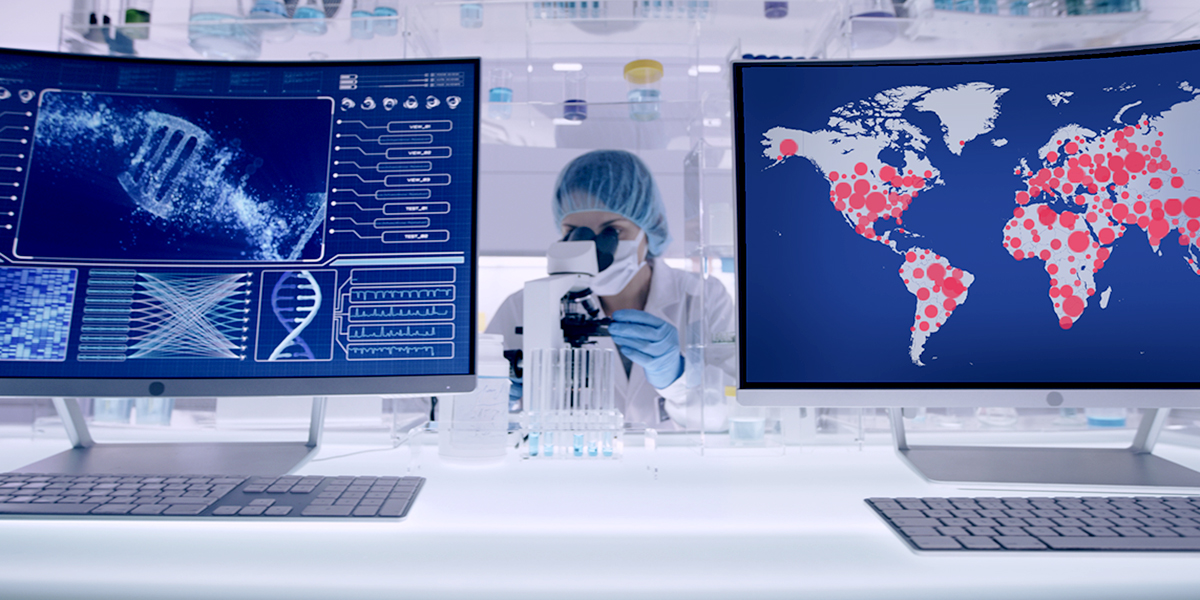
Introduction
There is no question that 2020 was a year of significant turmoil. In a matter of months, the SARS-CoV-2 coronavirus showed how swiftly a deadly infection could take over our globalized world and wreak havoc. While this pandemic has brought immense tragedy, killing millions of people worldwide, it has also provided scientific opportunities and new capacities for a pandemic response.1 Whole-genome sequencing is one area in particular that stands out as having a profound effect on how we study viruses and develop treatments.
Sequencing has played an enormous role in our understanding and response to the SARS-CoV-2 virus. Recent advances have not only enabled rapid identification of the virus but have also prompted development of diagnostic tests and tools.1 In addition, it was on the basis of very early sequences of the SARS-CoV-2 virus that the initial designs for mRNA-based vaccines were created and deployed in record time.
To understand the evolution of our approach to the pandemic, it’s helpful to start at the beginning, and look at how our recognition of this novel pathogen began — with sequencing data. As researchers grew concerned over the emergence of an atypical respiratory illness circulating in hospitals in Wuhan, China, they isolated and studied patient samples and were confronted with the reality of a novel coronavirus revealed by sequencing that would change the world as we knew it. It was early sharing of SARS-CoV-2 genome sequences that allowed molecular diagnostic assays to be developed rapidly, which improved global preparedness, and contributed to the design of countermeasures.
Increased recognition that viral genome sequencing can play a role in improving public health is driving more laboratories to invest in this area. However, the cost and work involved in gene sequencing are substantial, and laboratories need to have a clear idea of the expected public health returns on this investment.1
By far the most widespread application of discovering effective methods for sequencing SARS-CoV-2, however, has been in the deployment of an unprecedented network of labs – many at the grassroots level – to collect and share sequences of viral samples from infected individuals to track the emergence, evolution and spread of SARS-CoV-2 variants. It is through these efforts that the names of a succession of variants – Alpha, Beta, Delta, and Omicron – became household terms.
The current wave of Omicron variant infections that has swept the globe since late November 2021 has placed renewed emphasis on the role that sequencing plays in our response to the SARS-CoV-2 pandemic.
Sequencing Identifies New Potential Variants of Concern
Arguably the most critical role that sequencing of SARS-CoV-2 serves is to detect the emergence of new variants that harbor combinations of mutations that can indicate changes in viral transmissibility or pathogenicity.
In the case of Omicron, discovery of this new variant in November 2021 by researchers in Botswana and South Africa was quickly followed by analysis of its genome. It showed that mutations in the Spike protein sequence of this new variant were sufficient to cause the virus to be less recognized by antibodies in individuals who had been previously infected or vaccinated against earlier strains of SARS-CoV-2. This prediction – initially based on sequencing data alone – has subsequently been confirmed as countries around the globe continue to experience an unprecedented wave of new cases.
Ongoing Global Pandemic Surveillance Monitoring
Just as the Omicron variant has displaced earlier, less transmissible forms of the virus, it is inevitable that additional variants will emerge and threaten to repeat the cycle of new waves of viral infection. Coordinated efforts to sequence SARS-CoV-2 genomes worldwide and sharing of that genomic data through platforms such as GISAID, provides a crucial sentinel system to support public health awareness and preparedness.
The WHO recommends surveillance sequencing of at least 5% of cases to detect new potential variants before they spread and become more common. Scalable methods of generating high quality genomic datasets from large numbers of viral samples will be critical in helping to achieve this vision of robust ongoing surveillance for future variants.
Efficient and Highly Multiplexed Whole Viral Genome Sequencing of SARS-CoV-2 Samples
Viral whole-genome sequencing data can assist COVID-19 epidemiological research, particularly when combined with other types of data (e.g., geographical case counts). One obstacle to scaling up sequencing for COVID-19 applications is preparing NGS libraries from 100s or 1,000s of SARS-CoV-2 samples per day to match the throughput required for cost-effective sequencing.2
At seqWell we have been working with public health labs and research institutions to help scale their viral sequencing pipelines with our plexWell™ technology, a workflow with high sensitivity and scalability that can allow high-throughput SARS-CoV-2 sequencing. These NGS library preparation kits were designed to enable sequencing of up to 2,304 samples in a single sequencing run, providing researchers with the ability to obtain high quality results while reducing time and cost of sequencing efforts.2
Conclusion
If the past several years has shown us anything, it’s how quickly the scientific community responds to global health crises. With the use of effective methods and innovative technologies, scientists are able to rapidly sequence SARS-COV-2 and share virus genomic sequence data globally, which contributes to our understanding of transmission, helping us design effective mitigation strategies.1
As we continue to face the wrath of this virus, predicting future COVID-19 epidemic trends is critical. Fortunately, we’re becoming more prepared every day.
Contact us to learn more about how plexWell technology can maximize your SARS-CoV-2 sequencing efforts.
References
- World Health Organization. Genomic sequencing of SARS-COV-2: A guide to implementation for maximum impact on public health. https://www.who.int/publications/i/item/9789240018440
- Efficient and Highly Multiplexed Whole Viral Genome Sequencing of SARS-CoV-2 Samples. http://seqwell.com/wp-content/uploads/2021/08/AppNote_SARS-CoV-2-Sequencing_112020.pdf
